June 2, 2014
Perhaps you've decided that you're simply tired of sickeningly sweet sports gels.
Maybe it's the candy-like taste.
Maybe it's having your brain wired on a potent combination of caffeine and sugar for hours after your workout or race.
Maybe it's knowing that every time you dump boatloads of sugar into your body, even during the relatively insulin-sensitive state of exercise, you can still rip yourself out of fat oxidation.
Maybe it's all the damaging and deleterious health effects of chronic blood sugar surges that you just learned about in my last article “Rewriting The Fat Burning Textbook: Why You’ve Been Lied To About Carbs And How To Turn Yourself Into A Fat Burning Machine.“
But no matter why you're interested in lowering your intake of sports gels, there's a problem: even though you can go for hours and hours exercising with your own adipose tissue as a fuel source, for long, sustained and relatively difficult exercise efforts that exceed 2-3 hours in duration, you still should use a quick and convenient source of extra energy if you want to minimize central nervous system fatigue and maximize activation of ATP production via fatty acids and amino acids pouring into the Krebs cycle…
…and a small, portable packet of calories can be an efficient way to accomplish this.
So in a situation like this, why not just use something like the liquid Endurance Pack that I've talked about in the past? After all, that pack is simply amino acids, medium chain triglycerides, and a very slow release form of high molecular weight starch – so it doesn't present any of the performance or health issues of sweet, sugary solutions. There are three reasons why liquids sometimes simply don't work or need to be accompanied by other fuel sources:
1) Liquids needs to be carried in either flasks or water bottles, and I've found that when doing races such as a Spartan or obstacle course event (in which you're often rolling or crawling on the ground) flasks and water bottles get smashed, leak, and can press up against your body in very uncomfortable ways.
2) Sometimes you need a “break” from the texture of liquids, and especially during long events such as an Ironman triathlon, you may find yourself either something to chew on, or something that has more of a gel-like texture.
3) Pre-made gels require no previous forethought, planning or mixing. You just put them in your pocket and…go.
Fortunately, when it comes to venturing outside of the realm of glucose, fructose, maltodextrin, honey and the other common sources of sugar used to form the base of most gels, there are a variety of options. So below, you will find 12 fat-based alternatives to sickeningly sweet sugar-based sport gels. If you have questions, comments, feedback, or your own additions, then leave them below this post and I'll be happy to reply!
———————————-
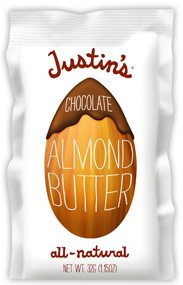 Option #1: Justin’s Nut Butter
Option #1: Justin’s Nut Butter
Justin's Nut Butter Ingredients:
-Dry Roasted Almonds
-Organic Cane Sugar
-Organic Cocoa
-Organic Cocoa Butter
-Palm Fruit Oil
-Sea Salt
Justin's Nut Butter Nutrition Label:
My Take:
Anytime you see “cane sugar”, this means that a gel contains a disaccharide sugar comprised of fructose and glucose mixed in a 1:1 ratio – very similar to table sugar but with a possibility of slightly higher nutrient density. You can read up more on cane sugar (the sucanat version) here. Two different sugars means that you're using two different sugar transporters in your gut, which may help absorption of the sugars. But ultimately, with only 9g of carbs – compared to 30-60g of carbs in a standard sugar-based gel serving with this many calories – this is kind of a moot point.
Justin's uses palm fruit oil because it minimizes oil separation – and although this isn't a completely natural oil, they do source their palm fruit oil from a sustainably harvested farm in Brazil, so it contains no trans-fatty acids and has much less damaging effects compared to the hydrogenated oils used in many similar products. You can read more about palm fruit oil here.
Justin's Nut Butter tastes excellent, and the cocoa is a nice touch. But note that it contains 190 calories in one gel – so if you're accustomed to the 80-100 calories of energy in a standard sugar based gel, you'll get a stomachache fast if you try to match this gel-for-gel with what you're used to eating. Because of this, most folks will do just fine on ONE of these Justin's Nut Butter servings per hour, with larger athletes or males potentially doing OK with two. In either case, I'd recommend you take it in smaller doses, like half the packet at a time, along with 4-6 ounces of water.
———————————-
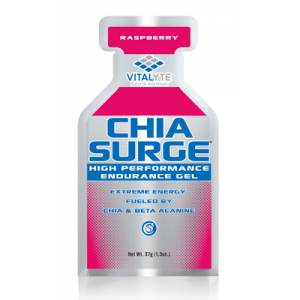 Option #2: Vitalyte Chia Gels
Option #2: Vitalyte Chia Gels
Vitalyte Ingredients:
-Water
-Dextrose
-Maltodextrin
-Citric Acid
-Fruit and Vegetable Juice (for color)
-Natural Flavor
-ULS (Organic Cane Sugar, Natural Flavors, Stevia)
Vitalyte Nutrition Label:
My Take:
This gel has whole chia seeds in it, so it definitely has a bitty texture that will have you picking bits of chia out of your teeth after you use it. I find this slightly annoying, although I definitely recognize the long term energy benefits of the amino acids and fatty acids present in chia seeds.
Chia seeds have a long history as an endurance fuel. Ancient Aztec tradition held that an ounce of chia seeds could sustain a warrior for 24 hours. Today, chia is considered a superfood because it has more Omega-3’s than any other crop in the world, it has more antioxidants than blueberries, it is a complete protein, providing you with all 9 Essential Amino Acids (important for preventing muscle breakdown when exercising longer than 2 hours), and it has 25% soluble fiber. A chia seed can absorb 9-12x its bodyweight in water – and this helps regulate absorption, which can prevent sugar spikes and crashes. So despite the issue with having to pick it out of your teeth, I'm a fan of chia.
However, Chia Surge also has relatively high amounts of dextrose and maltodextrin compared to the amount of fat in the gel and overall, very few calories (75kcal) in an actual serving – so you'll need to carry quite a few of these for a very long event. I do like that Chia Surge contains beta-alanine (which has been shown to improve sprint performance), though the amount included is pretty small compared to how much beta-alanine is used in most studies. You may also find that the lactic acid buffering combination of beta alanine and the BCAA’s in Chia Surge creates a tingling sensation – which you may find uncomfortable. A big bonus is that Chia Surge also contains Palatinose, a low-glycemic index sugar that can increase the amount of fat you use as energy.
The biohacker in me likes the stuff like chia, beta-alanine and palatinose. The 180 pounds of me just wishes this gel contained a slightly higher calorie punch so I can carry fewer of them.
———————————-
 Option #3: GU Peanut Butter
Option #3: GU Peanut Butter
GU Peanut Butter Ingredients:
Ingredients:
–Maltodextrin
-Water
–Fructose
-Peanut butter (peanuts, salt)
-Amino acids (leucine, valine, histidine, isoleucine)
–Potassium and sodium citrate
-Antioxidants (vitamin E and C)
-Preservatives (sodium benzoate, potassium sorbate)
-Calcium carbonate
-Sea salt
-Fumaric acid
-Calcium chloride
-Pectin
-Citric acid
-Malic acid
-Herbal blend (chamomile, ginger).
GU Peanut Butter Nutrition Label:
My Take:
Compared to the other GU's, the peanut butter flavor is less sweet and has more amino acids, more sodium, more potassium and more fatty acids.
But if you're Paleo, don't eat peanuts, have a peanut allergy or are concerned about aflatoxins, this may not be a good option for you. Aflatoxins are natural toxins produced by certain strains of the mold Aspergillus flavus and A. parasiticus and are known to grow on peanuts and other crops stored in warm, humid environments. Since peanuts are highly susceptible to aflatoxin, many companies take careful initiatives to make sure that their products are safe for the market. I'm not sure if GU tests rigorously for aflatoxins, but this is one concern for me.
I have to admit that this gel tastes awesome, the calorie count (100kcal) is about perfect, the chamomile and ginger are an excellent touch for soothing your stomach, and the Branched Chain Amino Acids are a good addition for staving off central nervous system fatigue – but I'd personally rather go with a nut such as almond (e.g. Justin's Nut Butter, Pocketfuel, etc.)
———————————-
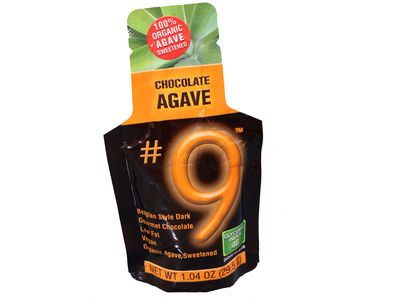 Option #4: Chocolate #9
Option #4: Chocolate #9
Chocolate #9 Ingredients:
-Organic agave nectar
-Breakfast cocoa processed with alkali
Chocolate #9 Nutrition Label:
My Take:
This is a unique one. The only ingredients are Agave and Cocoa. Agave is mostly fructose, and the amount of fructose in it is a bit too slow to be absorbed adequately (and can be difficult to digest), which is why fructose does much better for exercise when mixed with glucose or maltodextrin. And the fructose by itself from agave can taste way too sweet. But ultimately all this is kind of a moot point since we're primarily interested in the fats anyways.
So what the heck is breakfast cocoa anyways? According to the FDA, Breakfast cocoa, also known as “high fat cocoa” is a food prepared by pulverizing the material remaining after part of the cacao fat has been removed from ground cacao nibs. Breakfast cocoa contains no less than 22 percent by weight of cacao fat, so it's pretty low-glycemic index stuff. However, lest you be interested in all the health benefits of dark chocolate, the fact that the breakfast cocoa is processed with alkali means that most of the antioxidants in the cocoa are destroyed. This is also an extremely thick gel and is almost more like a paste than a gel (and nearly impossible to squeeze out if it gets cold).
I must admit: I actually kind of like the taste of Chocolate #9. But similar to Chia Surge, you'd have to carry a lot of these gels, and you may not dig the texture.
———————————-
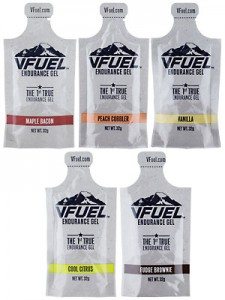 Option #5: VFuel
Option #5: VFuel
VFuel Ingredients (Peach Cobbler flavor):
-MaltoDextrin
-Water
-Dextrose
-VFuel Endurance Formula (MCT Oil, Taurine, Glucuronolactone, Ornithine Alpha-Ketoglutarate)
-Citrulline Malate
-Magnesium Aspartate
-Sodium Citrate
-Potassium Aspartate
-Organic Peach Flavor
-Potassium Sorbate
-Sea Salt
-Caffeine
-Cinnamon
VFuel Nutrition Label:
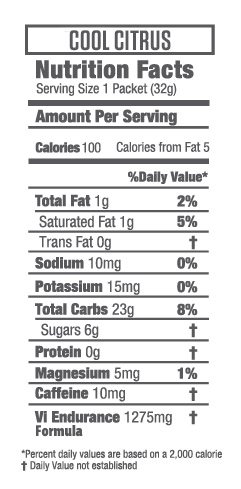
My Take:
VFuel has zero amounts of fructose, so if you have a fructose malabsorption, intolerance or allergy, then it's a good choice. Unfortunately, the very small amount of fat it has in the form of Medium Chain Triglycerides (MCT), is not very significant, and it packs a relatively large wallop of carbs (23g) compared to many of the other gels I review in this post. Ultimately, I”m not sure if the VFuel Endurance Formula (MCT Oil, Taurine, Glucuronolactone, Ornithine Alpha-Ketoglutarate) contains high enough amounts of the fat-based ingredients to make much of a difference compared to the amount of sugar.
This stuff actually reminds me quite a bit of the GU Roctane I used to use during my Ironman triathlons, but with a little bit of MCT added in. However, I like that they flavor their gel using natural sources. For example, in the chocolate they use only organic, non-alkalized (that means the antioxidants aren't destroyed), real cocoa powder and a hint of pure, real vanilla. In their peach cobbler, they we use organic natural peach flavor to get as close to the real flavor as possible, then add a dash of ground cinnamon. There are no frills, no synthetic blending of ‘flavors,’ and no additives.
———————————-
 Option #6: Huma Gel
Option #6: Huma Gel
Huma Mango Flavor Ingredients:
-Mango puree
-Evaporated cane juice
-Filtered water
-Brown Rice Syrup
-Ground chia seeds
-Sea salt
-Citric acid
Huma Nutrition Label:
My Take:
Hüma is based on the Tarahumara Indians of Mexico. Using “Tarahumara” as a name would have been far too long for our gel package, so they chopped it down to “Hüma ”.
Like VFuel, Huma still has lots of carbs in it, with the addition of a small amount of chia seeds. However, they claim that it is 100% stomach-problem free due to their blend of sugars. Sports nutrition research does indeed indicate that consuming sugar blends with a ratio of 2:1 glucose to fructose increases carbohydrate absorption by the body, compared to a single isolated sugar source. As you learned earlier, evaporated Cane Juice has a chemical composition of 1:1 glucose to fructose, and Brown Rice Syrup is 100% glucose. So together, they provide you with the “ideal” 2:1 ratio. But it's still sugar. Sure, the fiber content of the chia seeds acts to modulate carbohydrate absorption,
Hüma gels have a higher water content than other gels, which makes them easier to swallow and digest, but that also means fewer calories per ounce, so they have to put more gel in the package to get you the 100 calories that I like to see in a gel – meaning a larger package. So it's a lot of bulk for relatively few calories and a big hit of sugar. Once again, this is better than a strictly sugar-based gel, but not the best choice in my opinion.
———————————-
 Option #7: Pocket Fuel Naturals
Option #7: Pocket Fuel Naturals
Banana Blueberry PocketFuel Ingredients:
-Dry roasted almonds
-Organic cane sugar
-Banana chips
-Dried blueberries
-Sunflower oil
-Sea salt
Banana Blueberry PocketFuel Nutrition Label:
My Take:
PocketFuel Nut Butter blends are made from 100% natural, whole food ingredients found in nuts, seeds and fruits. Their blends are packed with many B-complex group of vitamins such as riboflavin, niacin, thiamin, pantothenic acid, vitamin B-6, and folate, which function as co-factors for enzymes during cellular substrate metabolism. Because of the mix of nuts and fruits, they are also a rich source of minerals like manganese, potassium, calcium, iron, magnesium, zinc, selenium and sodium.
I'd rank PocketFuel right up there with Justin's Nut Butter, with most of the advantages I've already mentioned related to gels that are comprised primarily of nuts, with relatively low amounts of sugar. These PocketFuels are larger than most other gels (about 1.8oz compared to 1.0oz) but have far more calories (~280kcal) due to their higher fat content.
From a pure taste standpoint, this is my favorite fat-based gel. I really dig that all the sugars are from natural fruits, and there are also MCT's from the coconut oil. If I had to choose any of the gels I've discussed so far, PocketFuel would have to rank as one of my favorites. Dangerously addicting, however.
———————————-
 Option #8: Peanut Butter Hammer Gel
Option #8: Peanut Butter Hammer Gel
Hammer Gel Ingredients:
-Maltodextrin
-Water
-Peanut Butter (Dry Roasted Peanuts, Dextrose, Hydrogenated Cottonseed and Rapeseed Oil, Salt)
-Energy Smart® (Grape Juice, Rice Dextrin)
-Salt
-Sodium Acid Sulfate
-Potassium Sorbate (as a preservative)
-Amino Acids (L-Leucine, L-Alanine, L-Isoleucine, L-Valine)
-Potassium Chloride
Hammer Gel Nutrition Label:
My Take:
This unique flavor from Hammer is very, very similar to the GU Peanut Butter I mentioned earlier. Like GU, Hammer adds none of the “ose” sugars such as dextrose, glucose or sucrose, ranking these as recommend to avoid due to:
1) inconsistent and short-lived “flash and crash” energy; 2) very low and almost always inadequate amounts of calories that the body can assimilate and utilize for energy, with a calorically weak simple sugar concentration of 6-8% being the limit and higher concentrations necessary in a gel based format being digested less efficiently, resulting in an increased risk of digestive problems such as nausea, bloating, cramping, and diarrhea; 3) increased potential for overhydration and its host of associated problems (when you try to fulfill your body's calorie requirements by consuming increased quantities of simple sugar-containing energy gels, you must drink copious amounts of fluids to adequately digest them).
Kudos to Hammer for, similar to GU, adding BCAA's to this blend. Unlike GU, there is no chamomile and ginger in this blend, although Hammer does have it's “EnergySmart” Grape Juice and Rice Dextrin in it. Since we're trying to avoid sugars, this isn't very relevant. Ultimately, since I'm trying to avoid many peanuts anyways, I'd be more prone to use a nut butter based on almonds.
———————————-
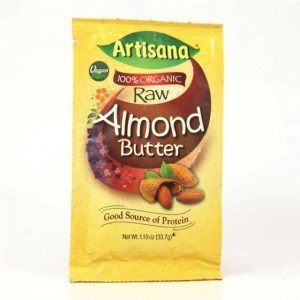 Option #9: Artisana Foods
Option #9: Artisana Foods
Artisina Almond Butter Ingredients:
-Organic raw almonds (California)
Artisina Almond Butter Nutrition Label:
My Take:
Artisina is a pretty interesting company. They not only make the almond butter featured above, but also Coconut Butter made from raw 100% Organic Pure Ground Coconut Flesh, a packet of raw 100% Organic Extra Virgin Coconut Oil and also cashew butter, pecan butter, walnut butter, macadamia butter, raw Organic Chocolate & Coconut Butter Decadence – all in squeeze packs, all organic and all raw.
They are Peanut , Gluten, Soy & Dairy Free. They are certified both Organic & Kosher. They do not add any extra oils, sugar, emulsifiers or preservatives. All you are getting is the good clean nutrition from the nuts. And the amazing thing about Artisana is that with no preservative, it is still completely Shelf Stable, with no need for refrigeration, even after opening, for up to 18 months.
Due to the low sugar, high fat and incredibly versatility of their fat-based sources, allowing you to choose a fat that works well for you, this one ranks right up there for me with PocketFuel and Justin's Nut Butter. These are well worth trying, and are mind-numbingly tasty.
———————————-
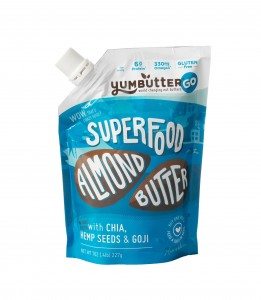 Option #10: YumButter
Option #10: YumButter
YumButter Ingredients:
-Dry roasted California almonds
YumButter Nutrition Label:
My Take:
I love the social message behind YumButter. Here are some of the ways they're creating social and environmental goodness:
-Leading socially-conscious nut butter company
-14,000 feedings for children with malnutrition
-Over 4% of revenues contributed to social good in 2012
-B Corp score of 87 (other sustainable businesses score 80)
-Offset 36 tonnes of CO2 (~250% more than we create) through reforestation
But here's my beef with YumButter (even though it tastes amazing and ranks right up there with Pocketfuel in terms of it's tasty combination of fruits and nuts):
At about 227g, or around the size of a running flask, the packet is just too freakin' big to carry around for anything except perhaps a bicycling century. I simply can't stuff this in my pants at the start of a Spartan race and have it not be one big flattened mess the first time I roll through a barbwire obstacle, or have it in a pair of marathoning shorts without being extremely weighed down in whichever pocket this stuff is in.
But YumButter tastes really, really, addictively good, and I love their social message. Through their BuyOne:FeedOne model, they've been able to help feed over 14,000 children with malnutrition since mid-2012. That's pretty cool.
———————————-
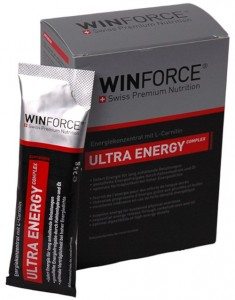 Option #11: WinForce
Option #11: WinForce
WinForce Ingredients:
-Sucrose
-Maltodextrine
-Water
-Hazelnut puree
-Coconut milk powder
-Vegetable oil blend (olive oil, coconut oil, sunflower oil, canola oil, wheat-germ oil, emulsifier: sunflower lecithin)
-Thickener: modified starch
-Hazelnut copra
-L-carnitine
WinForce Nutrition Label:
My Take:
I was intrigued by this one. It's the only vegetable oil based blend of the gels that I've reviewed so far. Their Ultra Energy Complex is based on five vegetable oils containing Omega-3 and Omega-6 fatty acids, and is free of artificial flavors, colors, sweeteners and preservatives. In addition, the L-carnitine contained in this product has been shown to enhance fatty acid utilization and recovery.
As you can see from the nutrition label, it does indeed contain maltodextrin and modified starch, but a standard 25g gel size portion is still under 13g of total carbs.
My biggest concern with Winforce was the potential for extracted vegetable oils, which are notoriously fragile compared to coconut oils, to become oxidized or laden with free radicals. When I wrote to Winforce, they informed me that:
“All 5 vegetable oils are mixed into the product and afterwords low temperature heated to make the product microbiological long term stable. The product is not oxidized. Because of its high content of omega-3 and omega-6 fatty acids the product has a good influence against inflammatory.”
In addition, rather than coming from American-based GMO crops, the oils in Winforce come from:
-olive oil: Italy
-coconut oil: Philippines
-sunflower oil: Switzerland
-canola oil: Switzerland
-wheat-germ oil: Switzerland
In the spirit of full disclosure, this is a gel with which I was unable to experiment with or taste prior to writing this article, but I am planning on ordering it very soon to trial, as I'm curious to see how the blend of the different oils compares to using solely a nut butter or solely a coconut oil or MCT oil base.
——————————————–
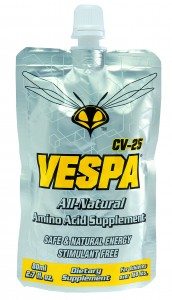 12. VESPA
12. VESPA
VESPA Ingredients:
-Filtered water
-Honey
-Royal jelly (240mg)
-Citric acid
-Bee propolis (120mg)
-Wasp extract (100mg)
-Ascorbic acid
VESPA Nutrition Label:
Not available, but here's the skinny:
-Serving size: 1 pack (80ml)
-Calories: 18
-Fat Calories: 0
-Total carbohydrates: 5g (2% of daily value)
My Take:
This is another unique one. VESPA’s key ingredient is an all-natural amino acid complex (in a naturally occurring peptide) derived from the Asian Mandarin Wasp (yes, a wasp) – and it works by shifting the muscles to metabolize a higher level of fat during physical activity, thus stabilizing and conserving your glycogen stores.
The Asian Mandarin Wasp (Vespa mandarina) is one of nature’s most potent endurance animals. It flies between 70-100 KM per day in search of food and carries half its body weight to its entire body weight in food back to the colony to feed to the larvae. The adult wasp does not eat this solid food, but instead it receives a liquid secreted by the larvae in a symbiotic relationship called “trophallaxis”.
Dang!
So this company called KAWAHARA Co., Ltd. (of Japan) developed a method for isolating this food source from the wasp, then putting it into every packet of VESPA. Note that there are only 18 calories in a whole packet of this stuff. So rather than being a source of calories, it's mostly allowing to better tap into the other fats you may have available. So it allows you to tap into your own adipose tissue more efficiently, or tap into fats you're getting from other sources more efficiently.
These things are spendy, so I'd use them sparingly, but I've mixed them very successfully with my other fuel sources (MCT oil, Superstarch, amino acids) during Ironman triathlons and it allows me to tap into the energy from those other fuel sources much better. For something like an obstacle race, I wouldn't carry this stuff, but instead (since it will last about 4-6 hours) just take a shot prior to the race, then rely upon other fuel sources during the actual event.
———————————————-
Summary
So that's it!
I'd have to say that out of all the sources listed above, my three favorites are Justin's Nut Butter, PocketFuel and any of the blends from Artisina. Then for the pure fat biohacking properties, if budget permits, I like a serving of VESPA taken prior to or with any of those fuel sources. If anything, you'll at least be able to tell your friends you ditched sugar and instead had nuts and wasp extract prior to your workout.
Now it's YOUR turn.
Which of the gels above have you tried? Which would you add?
Do you have questions, comments or feedback about any of these fat-based alternatives to sickeningly sweet sports gels?
Leave your thoughts below!

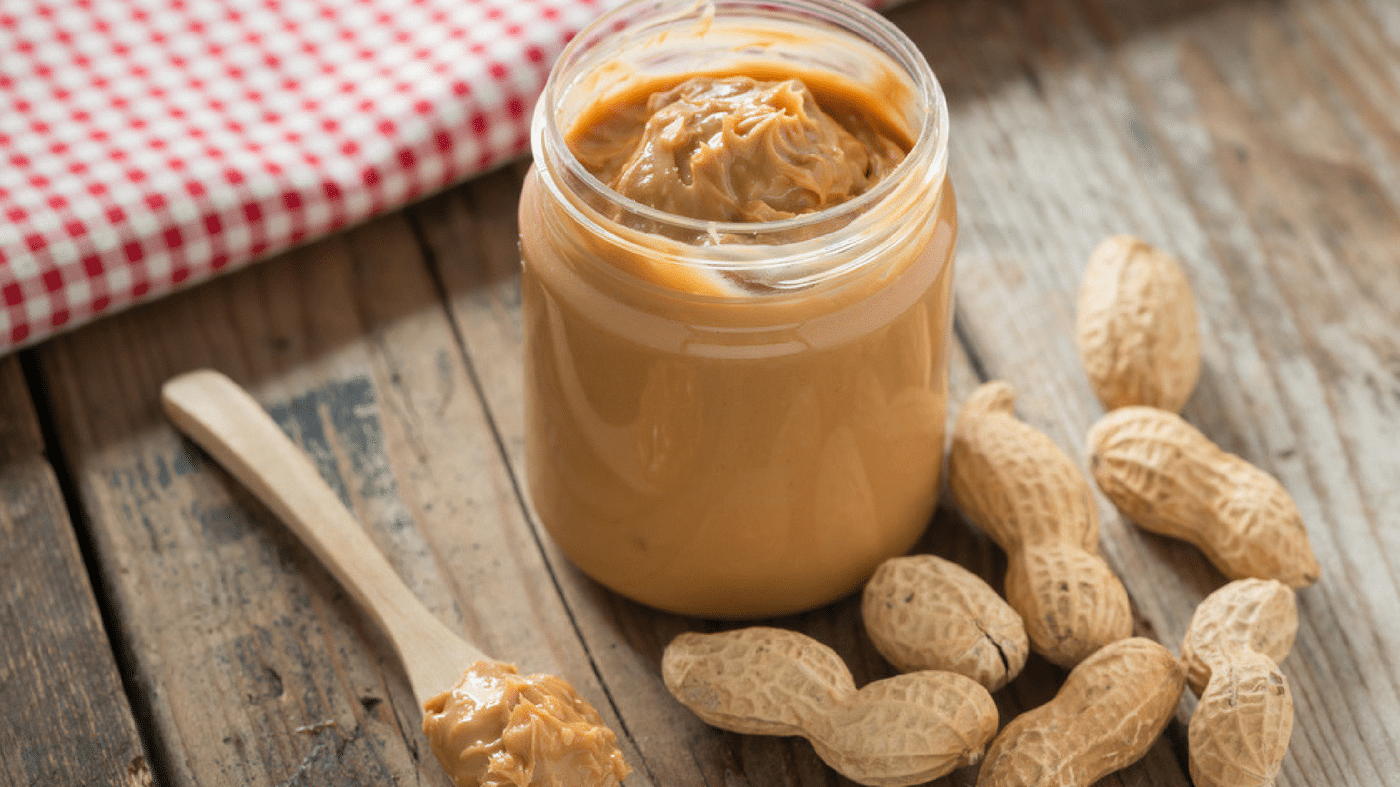

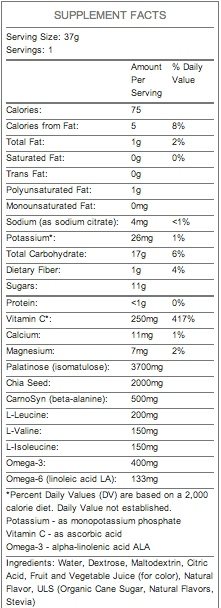
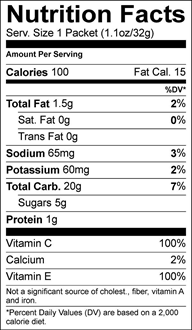
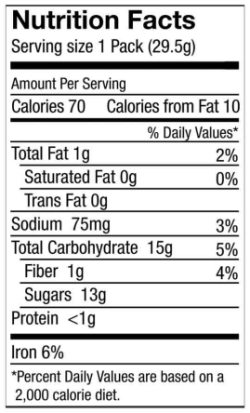
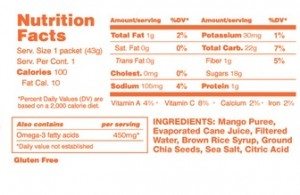
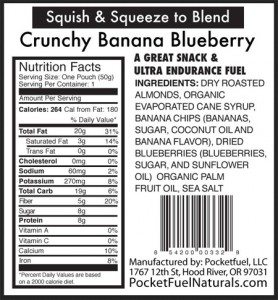
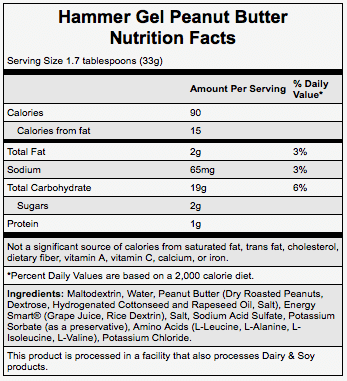
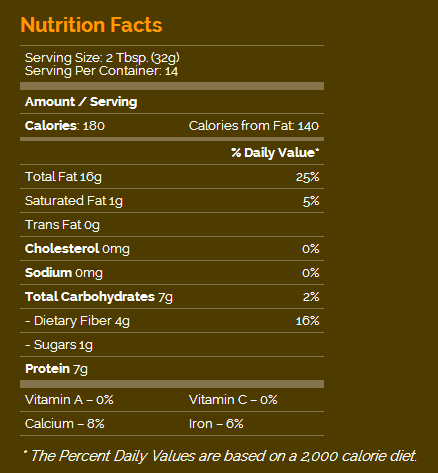
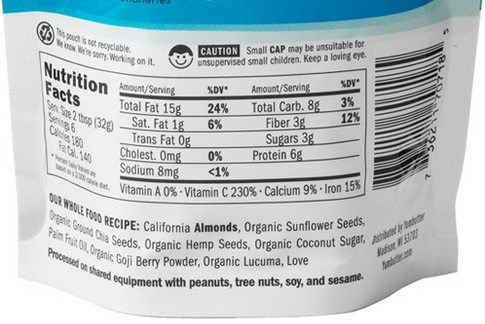
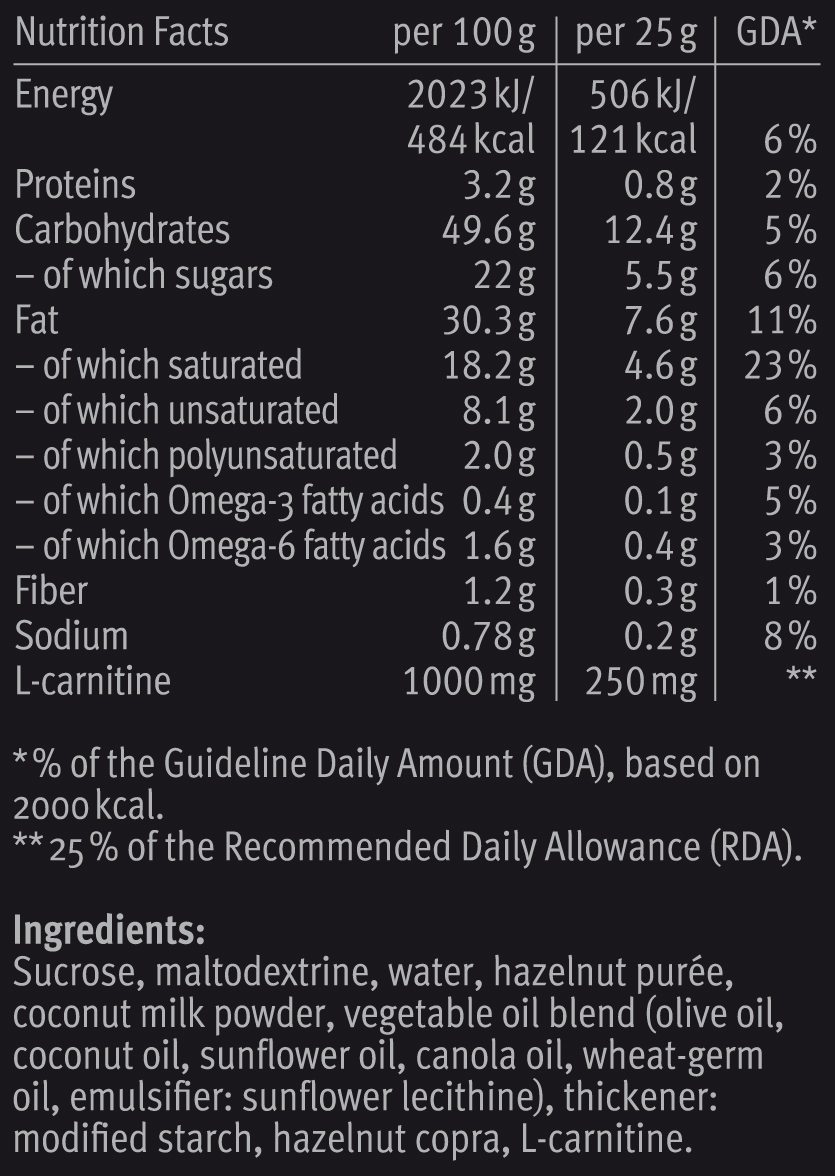
The article mentions that sugary sports gels can cause digestive issues for some athletes. Have you ever experienced this problem? If so, what alternative energy sources have you found to work well for you?
Ben thank you so much for giving us the useful information. Really love this article!
You can find a definitive list of natural and raw energy gels which don’t have any Maltodextrin or added processes to their ingredients here https://www.outdoorfood.club/food/rankings/energy-gel/raw-and-natural-energy-gels
A lot of these have maltodextrin which is nasty, sugar which most people don’t want, and/or nuts which many people are allergic to.
What’s your take on Spring Nutrition Gels? Got a 1/2 IM coming up and was thinking of giving em a shot, any insight would be great.
MIchael
Haven't tried those ones.
What are your thoughts on the new RX Nut Butter packets? I would like to substitute these for the Gu’s that I currently use for long runs.
From my experience they are thick and challenging to get out of the package when it’s cold and they take some kneading. I used an RX nut butter and Nuttzo 2go. Nuttzo is very similar but a little smaller — roughly 100 cal per pack versus RX 190 cal. I would recommend checking them both out.
Hi there,
Not seeing Pocket Fuel Naturals on Amazon. Where do they distribute or who sells them online?
Many thanks!!
Seems they've gone out of business. Here's a really good one I've used since this article was published… BenGreenfieldFitness.com/ketomanna
Hi! Did you ever find the pocket fuel naturals? I’m looking too. Everything I read makes them sound amazing, but I don’t know where to buy.
Thanks!
Hey Ben, thanks for the great article!! Im in Europe and cant find the justins almond butter but can find the hazel nut butter, what do you think? they look pretty much the same apart from some more carbs.
Serving Size 32g
Calories 180
Calories from Fat 130
Total Fat 14g 22%
Saturated Fat 2.5g 13%
Trans Fat 0g
Cholesterol 0mg 0%
Sodium 65mg 3%
Total Carbohydrates 12g 4%
Dietary Fiber 3g 12%
Sugars 7g
Protein 4g
Vitamin A 0%
Vitamin C 0%
Calcium 4%
Iron 6%
thanks!
A good alternative!
Mr. G,
Great article, but it begs the question – why not make your own fuel? It seem to me that you can “just” blend your coconut oil, almonds, cocoa, blueberries, and honey/cane sugar in a ration to your need – and the find a decent way to adminiter it during your bike/run? Am I completely off?
Been there, done that, and it's always resulted in a concoction that doesn't travel well to races, creates a complete mess trying to squeeze out of anything, and is very difficult to dose properly.
Right. GU has a refilable gel bottle (and otters probably has similar products). As a triathlete, I think I want to try a home mix for the bike, and perhaps stick to Justins Nut Butter on the run. Justin’s are a bit to tricky to handle on the bike IMO – can be rather messy.
Maybe a MCT oil, amino acid pulver, and nut butter with a bit of honey mix will flow nicely….
Hi, last time I ordered Spring Energy Gels and they are made from real food. They taste great and i do not have stomach problem using those gels.
Did you try them?
not yet!
Where did you order Spring from please? Their website shipping is outrageous!!! Thank you
I’ve heard great things about spring energy gels. Where did you purchase them?
Hi Ben,
Great article! I was wondering if you have ever tried/heard of Muir Energy? I heard about their ingredients and it looks great, but nervous to order. Do you have any incite?
not yet, but I will check out…the slow fat burner actually looks like a good profile…
Did you ever get a chance to try Muir Energy? I’m quite curious about your take on that one. Thanks!
I haven't.
Hi Ben. Thank you for the excellent content. I just came across this recipe for homemade energy chews using agar agar powder, fruits, chia & baking soda. This seems interesting to me. I like to mix in some of the mass market chews for Spartan fueling. Planning to experiment with this more natural version if it seems like smart fueling. Will try to reduce the sugar and add more fat.
Hi Ben and community. Thank you for this really helpful article. Does anyone have thoughts on the use of agar agar powder to make homemade energy chews? I came across this article and the recipe looks interesting.
https://totalwomenscycling.com/fitness/natural-energy-gel-recipe-strawberry-chia-gelly-cubes
This is not one that I personally have information on… hopefully someone from the community can jump in!
Hey Ben,
Is it possible to get all of the energy you would need for an ironman race without these gels? Just eating the actual nuts, sources of good fats, etc?
I did a 50km trail run fuelled with only cashews, apricots and a mixture of sweet potato mashed with coconut milk. Messy, but it worked. Are there significant advantages to these packaged fuels over natural fuel sources, other than the convenient packaging?
Yes, but those solutions you propose are NOT aerodynamic or light, which is where gels and "engineered" fuels can come in handy!
Hi Ben,
Do you know if Pocketfuel Naturals no longer exists?
Wanted to try their gels but cannot find them on the interwebs.
Thanks.
Yeah, it looks like Pocket Fuel Naturals is no longer a thing. Too bad.
Ben, looks like it’s time to do another round up!
I recently bought your book and have read it. I love this article. It would love to try the Pocket Fuels, but I can’t seem to find them. Looks like they are no longer available. Looked high and low. Have you tried any of the others that have been recommended in the comments? Have you thought about doing an more recent article on what’s currently on the market now? I am trying to figure out the whole OFM diet. I have been in nutritional ketosis for the last 2+ months, but haven’t really ran more than 4 miles. Been crashing around 3.5. Today I push for 5 and struggled when I hit mile 4. Thinking about trying the VESPA and the nut butters. I have a half marathon coming up in 10 weeks and I start training next week. Then I will be running NYC marathon in November. If I do the VESPA and nut butters, should I drink some sort of electrolytes on course? If so, recommendations? Thanks so much.
I'll work on an update soon, but in the meantime, if you do VESPa and nut butters and you have a high amount of minerals in your diet you shouldn't need electrolytes but PRACTICE in your training before racing with any plan! I'd be happy to help you via a personal one-on-one consult. Just go to https://bengreenfieldfitness.com/coaching. and then choose a 20 or 60 minute consult, whichever you'd prefer. I can schedule ASAP after you get that.
Ben, Awesome Article. I love this vFuel. Have you any recommendation for winter in south asian?
Winter what?
What are your thoughts on Tailwind Nutrition?
Brock actually covered it here: http://www.skywalkerfitness.ca/tailwind
I just watched the video that Brock did on Tailwind and one of the last comments he makes is that Tailwind would not be appropriate for someone who is “doing the whole low carb thing.” So it sounds to me like he is saying that if we are working towards becoming fat adapted, we should avoid Tailwind. Any help would be much appreciated, as I just recently discovered your posts and podcasts on fat adaptation but have been using tailwind for ALL of my long runs and races for the past two years, which I think put me in a carb dependent state.
In my opinion, everything that I going to here is a far better alternative to something like tailwind, although tailwind, Skratch, etc.can be used in smaller amounts without deleterious effect, because they are indeed lower carbohydrate and say, a carbo pro or a power bar product: https://bengreenfieldfitness.com/2015/12/how-t…
Hi Ben, Thanks for a great article! I can use some guidance on race-day nutrition. I’m going into my 6th marathon this fall, hoping to beat my 3:21 PR. I’m a HUGE problem child with GI issues, and for the last 2 marathons, I’ve used Huma gel (non-caffeinated) every 5 miles, which requires me to carry 6 gels (1 for back-up), but without any GI problem. This summer, I started using UCAN pre-run with success, and also tried VESPA for one of my long runs. With both, I haven’t had to take anything else during the run and have been able to finish strong – and I’m up to 16 miles so far. My question is….can I mix the two during the same run, and if so, what’s your recommended combination? I can handle the chalky taste of UCAN when it’s nice and cold 60 minutes before a run, but not during the run when it’s warm. On the other hand, I have no problem with the bitterness of VESPA (I’m 115lb, so I’ve only used Junior so far). Any advice would be most welcome. THANKS!
Yes, you can mix UCAN and VESPA, and for something like that, if it were me, I'd including MCT oil and amino acids too, which would all mix into running belt with flasks or a sling style waist water bottle holder. A really good resource for you on mixes, etc. for this is this article: https://bengreenfieldfitness.com/2013/07/what-…
Ben, have you ever tried to use avocado for fuel? Obviously you can’t take a whole avocado with you on a Spartan race but I’m strongly considering pureeing some with salt and lime and putting it in a pouch for this weekends beast. Thoughts?
It sounds messy but give it a try and let me know how it goes! Take a peek at this http://superhumancoach.com/benefits-of-avocados/
Hey Ben, thanks for your great contribution to health & fitness. I manage a sports nutrition company in Australia that is geared towards LCHF athletes. We just released a range of low carb sports gels that are pretty unique and relevant to your article. Unlike almost all of the gels mentioned in this article, our gels do not use any sugar, fructose, dextrose or maltodextrin. We only use the low GI carb Palatinose (i.e. isomaltulose) plus our Keto Gels are basically carb free with fat from extra virgin coconut oil and MCTs. I'm sure your followers will be interested. Check this link for more info: http://nutriscience.com.au/product-category/gels/
You should email me: [email protected] – I'd be keen to try some and see what they're like.
I love this post – so helpful! I'm looking for something, but I don't know if I'm looking for fat or carbs? I do 1 hr of kickboxing then go for a 5.5 mile jog. So, that's about 2 hrs. However, I'm upping my mileage, so it'll be over 2 hrs. I'll be doing long runs on Saturdays. I'm not doing 5-6 hr stuff here. More like 3-4 hr for now. So, do I want fat? Carbs? I'm paleo too. Vespa and Pocket Fuel stood out as my faves for clean ingredients. But I'm not sure if Pocket Fuel is too much fat for what I'm going for? Thanks for any input! ; )
This article may help you https://bengreenfieldfitness.com/2013/07/what-… and this one too https://bengreenfieldfitness.com/2013/07/how-m…
I meant Honey Stinger!
Yeah… they work OK but they're extremely high glycemic index and WAY different than what I am talking about here.
What about Hobey stinger gels? All natural and mostly just honey?
Yes, better than pure GMO sugars or fructose, BUT it is still not high in fat, or in amino acids.
I have taken up cycling, and one problem that I have is what to eat before a cycle and during the cycle. I do a lot of sportive cycle and the distance I do is about 80km to 120km.
How often should I have something while I’m doing these distance.
Many Thanks Christina (Ireland)
That is a very personal question. I can't answer that for you. It really depends on how fat adapted (or how much of a sugar burner) you are. Take a look a this https://bengreenfieldfitness.com/2014/05/how-m…
Thanks for the post, Ben. Since I don’t eat any form of refined sugar, I wanted to make my own. Since the post I have been mixing cashew butter and coconut butter together for my cycling and whitewater kayaking outings. I tried several different containers, and found this one works best:
Evriholder Dressing to Go Salad Dressing Container.
I am this close to ordering some PocketFuel, but I wonder if the pouches are too big to bring with you on a run? How would you carry it on a marathon?
They are only 50g. Slightly bigger than a regular sugary gel.
Thanks. I'm giving it a try!
Thanks for the info Ben. You mention that you don't like the “ose” sugars such as dextrose, glucose or sucrose, however, options #2 and #5 have dextrose so confused about that. Also, is Fructose OK? It is in several product options you mentioned but is it considered an "ose" product too? Thanks again!
Those products have relatively low amounts of ose's compared to the sugar based gels. The fat based gels have much smaller amounts.
Ok – so I'm still not finding an option that meets with your recommendations simultaneously…
1 – You've noted that we shouldn't do more than 1 Scoop of UCAN due to fermentation. So I'm starting with that but not using a second scoop. It's not because I don't feel like staying with UCAN but rather because you've noted we shouldn't do more than 1 scoop.
2 – The nut gels would be great, but they don't fit the suggested FODMAP requirements. The Justin's has far more than the max of 10 almonds allowed with FODMAP and the GU Peanut Butter has Fructose, which you've warned against.
I just can't find an option that fits the combination of your suggestions?? By the way, just received the case of Thorne Elevate you recommended. Going to try it out pre-track session in the AM!
Thanks Ben
I would recommend you TRY what I have already recommended and report back with your results!
Great stuff Ben. Thank you. In reviewing this information and cross-referencing it with the FODMAPS strategy you have me pursuing, it appears the GU PB would be the best option for events up to 3 hrs (since Almonds are on some of the FODMAPS lists). Am I reading you right on this one? Thought I'd follow the advice you'd provided me pre-race and then combine 1 GU PB with 1 scoop of UCAN unflavored since you noted that more than 1 scoop of the UCAN has fermenting potential.
Appreciate it!
If I were you I would not use the sugar based gels. I would the nut based ones. Pretty minimal amount of fermentation for those vs. gluc/fruc/malto blends.
I’d say stick to my original recommendations, as we worked up something custom for you BUT if you didn’t feel like staying with UCAN during the run I’d do the nut based gels + amino acids, but I wouldn’t do nut based gels + UCAN. Starts to get too complex…
Thanks Ben. So that's where I'm running into the proverbial wall. As you know, this is for marathon – around 2:40 target time – so need at least a couple hundred calories. UCan is fine, but you'd written not to use more than one scoop of that due to potential fermentation so I'm looking for a secondary source. If I'm not supposed to use more than 1 scoop of UCAN, what should provide the additional 100-150 kcal?
I re-read your reply above and am not sure if you meant "…I would NOT do nut based gels + UCAN?" (due to complexity?). Just not sure where to get that additional 100-150 kcal without going glucose, maltodex, fructose or 2nd scoop of UCAN in the process…
Thanks
If you don’t feel like staying with UCAN during the run, do the nut based gels + amino acids. Remember those gels have 170 calories in them each!
Great article! I swear by the Pocket Fuel products and finally can run without stomach issues. I find the ones with fruit harder to digest so wondering if the vanilla and chocolate flavors are still ok? Thanks for the great info and insight!
They are fine. You just won’t get the added benefit from the magic combo of fast and slow release!
Hey Ben
Read the article, awesome. I just started using the UCAN for fueling on efforts from 2.5hr upwards. I was previously using Vitargo, but have dropped that due to its insulin spiking. After trying the UCAN it just tastes like corn starch. Do you have any alternatives that might be less expensive and easily available in Australia? There is only 1 UCAN distributor here and its over the top in price.
Cheers
Steve
From one of my Australian based coaches, Have you tried to get UCAN in Oz? Works out about $2.50 a serving. Is that where you get it from? The starchiness is due to the fact that, well, it’s starch :) Most starch based products have the same graininess.
Some of his guys use Karbolyn instead and they prefer the taste (plus it is easier to source)
https://massivejoes.com/shop/supplements/goal/imp…
Thanks Ben
I took it one step further, as my wife an I own a supplement and vitamin store in Queensland, i've contacted the distributor and have asked to retail the product here in the shop. I should have thought about that first before asking the question, sorry about that.
P.S you book arrived yesterday and i can't put i down.
I have tried Chocolate #9 and I can say to all of you reading this – it works great.
Is there something special you could suggest for running in winter?
If you keep most of these gels close to your body (e.g. in a Spibelt against your skin) you should be just fine in the winter. The nut butters will do better than the coconut oil bases however!
Great stuff, Ben. Would you still take MAP if using Vespa? I usually take 10 before a race and 5 every 2 hours or so,
Yes, you can combine MAP and VESPA – and I actually did just that for both my Ironman races last year.
Hi Ben ~ I found this thread in the nick of time! I have an event tomorrow; have VESPA, Pocket Fuel and UCAN. You mentioned using these during the same event. I need to be there at 5:30 am, and live an hour away. 1. How to fuel so early? And ,2. for an event that can take up to 4 hours, how would one combine these fuels ? (Just received Beyond Training yesterday! Can't wait to dig in!)
First, don't do anything different for your race. That's my take.
Second, you need to read this: https://bengreenfieldfitness.com/2013/07/what-…
I am just starting to experiment with maintaining a high fat low carb diet. I primarily race sprint and Olympic distance triathlons and marathons. I realize that these event only last 1-2 hours and theoretically shouldn’t require much if any fuel during. How would you recommend or what would you recommend I fuel with during theses events to sustain top end speed while trying to stay fat adapted? I am just starting out with a HFLC diet with approx 20% calories from carbs. I also intend on drinking a battle proof coffe in the morning prior to races (mct oil, butter, and almonds butter). I think I should be fine with no fuel during the sprints but am curious about the Olympic distances specifically.
Thanks Ben! Love your articles and podcasts!
I’d start here: https://www.youtube.com/watch?v=Pn3bbxaexnQ
and here: http://www.trifuel.com/training/triathlon-trainin…
Ultimately, it’s going to be very individualized. I’d be happy to help you out via a personal one-on-one consult. Can you please check http://pacificfit.net/items/one-on-one-consultati… and then let me know if you have any questions? We can do 20 or 60 minutes, whichever you’d prefer.
Cheers,
Ben
Do you have a recipe you recommend for making your own? We have the reusable pouches for baby food, so we could be making our own
Oh yes. Homemade "healthy" gel recipes abound. Really good ones in here: http://www.enduranceplanet.com/tired-of-eating-ge…
This is EXACTLY what I needed. Thank you for the comprehensive post!
Not a gel, but I love to make a batch of these bars and take a couple with me in place of gels: http://www.marksdailyapple.com/primal-energy-bar-…
Ben, thanks for putting me on to these – I had no idea they existed. I have ordered some of Jason’s Nut Butter gels to experiment with. Have a question though… how long does it take from consuming a fat like Jason’s Nut Butter for it to go through the digestive system and become usable energy within the muscles? I assume this would also depend on the level of fat adaption of the athlete and their diet preceding the exercise… If so let’s assume we are talking about a well fat adapted athlete following a low carb diet…
Here you go! BTW, this is why I like the nut butters like PocketFuel that have some fruit so you get a combo of fast and slow release!
DIGESTION TIME OF VARIOUS FOODS
Water
when stomach is empty, leaves immediately and goes into intestines.
Juices
Fruit vegetables, vegetable broth – 15 to 20 minutes.
Semi-liquid
(blended salad, vegetables or fruits) – 20 to 30 min.
Fruits
Watermelon – 20 min.digestion time.
Other melons – Canteloupe, Cranshaw, Honeydew etc. – 30 min.
Oranges, grapefruit, grapes – 30 min.
Apples, pears, peaches, cherries etc. – digest in 40 min.
Vegetables
Raw tossed salad vegetables – tomato, lettuces, cucumber, celery, red or green pepper, other succulent vegetables – 30 to 40 min. digestion. –
Steamed or cooked vegetables
Leafy vegetables – escarole, spinach, kale, collards etc. – 40 min. – Zucchini, broccoli, cauliflower, string beans, yellow squash, corn on cob – all 45 min. digestion time
Root vegetables – carrots, beets, parsnips, turnips etc. – 50 min.
Semi-Concentrated Carbohydrates – Starches
Jerusalem artichokes & leafy, acorn & butternut squashes, corn, potatoes, sweet potatoes, yam, chestnuts – all 60 min. digestion.
Concentrated Carbohydrates – Grains
Brown rice, millet, buckwheat, cornmeal, oats (first 3 vegetables best) – 90 min.
Legumes & Beans – (Concentrated Carbohydrate & Protein)
Lentils, limas, chick peas, peas, pigeon peas, kidney beans, etc. – 90 min. digestion time
soy beans -120 min. digestion time
Seeds & Nuts
Seeds – Sunflower, pumpkin, pepita, sesame – Digestive time approx. 2 hours.
Nuts – Almonds, filberts, peanuts (raw), cashews, brazil, walnuts, pecans etc. – 2 1/2 to 3 hours to digest.
Dairy
Skim milk, cottage or low fat pot cheese or ricotta – approx. 90 min. digestion time
whole milk cottage cheese – 120 min. digestion
whole milk hard cheese – 4 to 5 hours digestion time
Animal proteins
Egg yolk – 30 min. digestion time
Whole egg – 45 min.
Fish – cod, scrod, flounder, sole seafood – 30 min. digestion time
Fish – salmon, salmon trout, herring, (more fatty fish) – 45 min. to 60 digestion time
Chicken – 11/2 to 2 hours digestion time (without skin)
Turkey – 2 to 2 1/4 hours digestion time (without skin)
Beef, lamb – 3 to 4 hours digestion time
Pork – 41/2 to 5 hours digestion time
Wow thanks for all that useful information Ben! So really the nut butter is suited to very long events / training sessions and not much advantage taking during the last 1.5 hours of the session / event assuming you are going to have a meal after you are finished. For example a Half ironman event taking under 4.5 hours, it would be useful to take before start and 1 and 2 hours into the event, but no point taking after 3 hours… although as you mention there is a small amount of cane sugar in Jason’s nut butter. But then again I guess if you look at nutrition for recovery after, and the window after you finish there is a delay in digesting the post-session meal, so it you were to take towards the end of the session it’s digestion would bridge that gap…. I think I have just answered my own question. I will go and experiment…
I recently started making my own nut butters and using them for fuel when running long. All it takes are nuts and a food processor. But I also add some cinnamon, stevia powder, and coconut oil to mine to give it a little more flavor and coconutty goodness (flavor and fat calories). Stuff is rocket fuel and really easy to make. More economical, too. Put it in a squeeze tube or an EZSqueezee for portability.
Ben have you tried or tasted Vegasport Gel? I've been meaning to give that one a try.
http://vegasport.com/product/endurance-gel/
I will have to check this one out too!
Ben, thanks for being so thorough in reviewing all the alternative options. Since I live in Northern Europe a lot of the alternatives you list are pretty hard for me to come by. Except the WinForce Gel, that’s pretty easy to get over here. I was a bit concerned about the vegetable oils in the ingredients. I’m glad the company got back to you with an honest answer about their product. I’ll have to give that one a try soon. Great review on alternative gels!!
Great article! I'm currently using Vespa and VFuel for ultras and long training runs. In a race, I alternate them every 1.5-2 hours. 2-3 hours on a training run (although I recently went 4 hours on one Vespa!). Calorie intake averages 50 cal./hr….the rest comes from fat (mine). :). I like Justin's NutButter if I start to feel hungry, and I definitely need to try PocketFuel. Thanks for the summary!
Ben, I'm confused as to how some of these can contain meaningful amounts of fat or protein dispite the macronutrient ratios shown on the labels. For instance, Chia Surge has 1g fat / 17g carbs / less than 1g protein. (And that is actually rounded up from about half a gram of fat, since it has only 5 calories from fat, which makes me think that the "less than" 1 gram of protein means it has even less than half a gram of protein.)
I understand that, like with UCAN Superstarch, the chia carbs are slower burning than sugary gels, but can it really be classified as a "fat-based" alternative to sugary gels, and does it really matter that it is a "complete protein," when it (apparently) has so little by gram-weight of fat and protein? Or is this small amount meaningful? I have similar questions about the others that have relatively small amounts of fat (and/or protein).
Look at it this way: when someone is consuming 30 gels over the course of an Ironman or 50+ over the course of an ultra or a MTB race, it's pretty significant.
Wow, this is useful stuff, thanks much. I hate to see so many highly-refined oils (rapeseed/canola, sunflower, etc) present in many of these, and your detailing them all is so helpful that I created a "blog comment log in" just to thank you :-)
I just scooted over to Perfect Fuel based on samnicaise's rec, and it looks pretty clean – interested in your more informed take on that.
GRACIAS!
I really enjoyed this article Ben. I learned a lot of great information. The information on chia seed and breakfast cocoa was interesting.
I like some of Hammer's products but seeing they use "Hydrogenated Cottonseed and Rapeseed Oil" in their peanut butter is not a selling point for me.
I saw a lot of water bottles, gels, and assorted packets lying in the mud at the Austin Spartan race.
Have you heard of Perfect Fuel…it fits the profile too! http://www.perfectfuelchocolate.com/
Awesome, I will check it out!
Ben, Love the article, but have a questions. You say that Vespa lasts 4-6 hours. They say to take one every 2-3 during competition. Is there a reason you space your intake out more? Is this N=1 testing or something else?
I actually did not want to make things too complex in the article, but on an Ironman I will indeed use VESPA every 3 hours – however, you get a great deal of benefit from simply using it directly prior to heading out to the door for a typical "long" session.